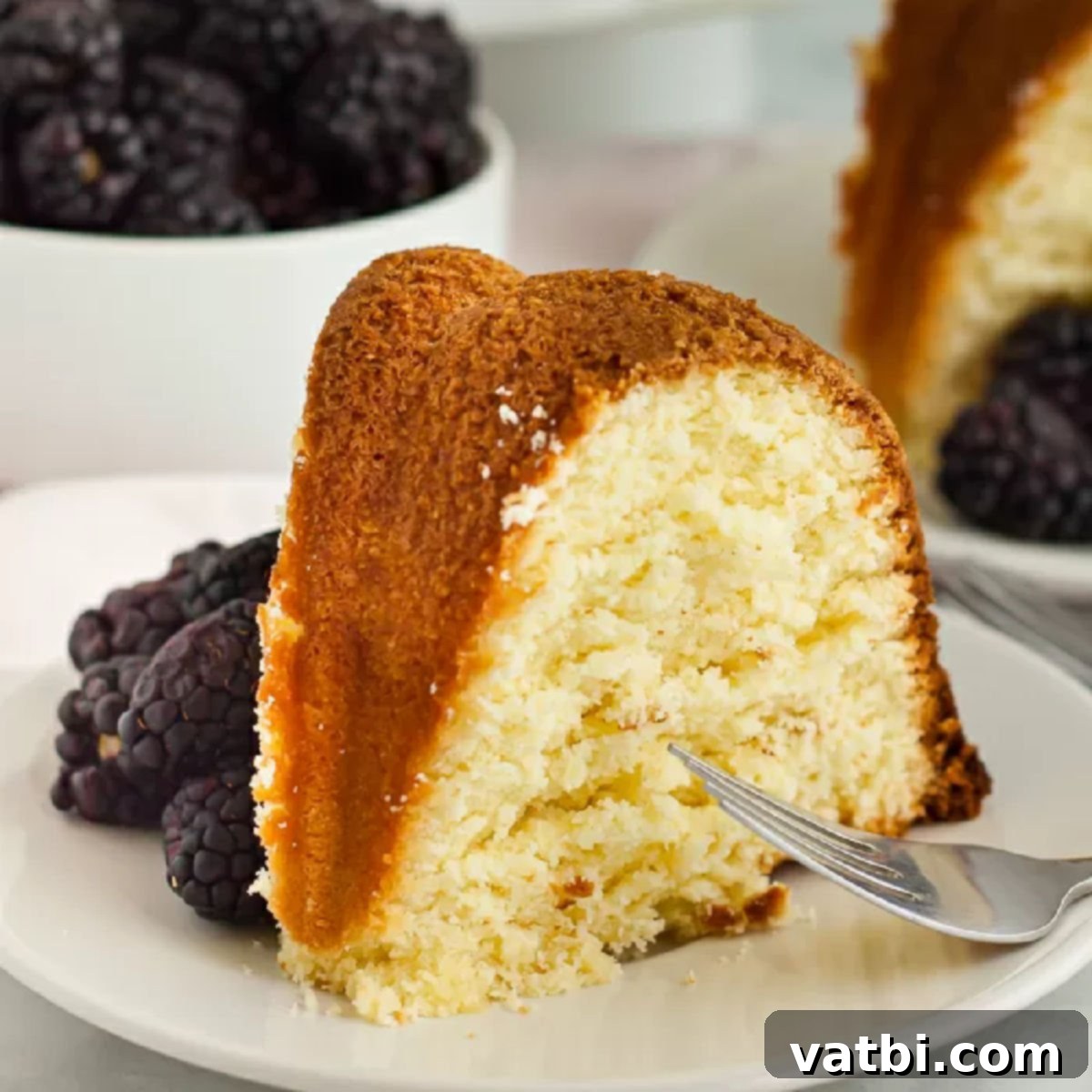The Ultimate Classic Easy Pound Cake Recipe: Bake a Perfectly Moist & Delicious Dessert from Scratch
There’s nothing quite like a slice of homemade pound cake – that perfect balance of rich flavor, dense yet tender crumb, and a comforting aroma that fills your kitchen. This Classic Easy Pound Cake Recipe is more than just a dessert; it’s a timeless favorite that brings smiles to every face. With just a handful of simple ingredients and straightforward steps, you can whip up this luscious cake that’s perfect for any occasion. My entire family adores it when I bake this cake, and it’s especially delightful when served with fresh berries and a dollop of whipped cream, making it an ideal treat for gatherings or a quiet evening at home.
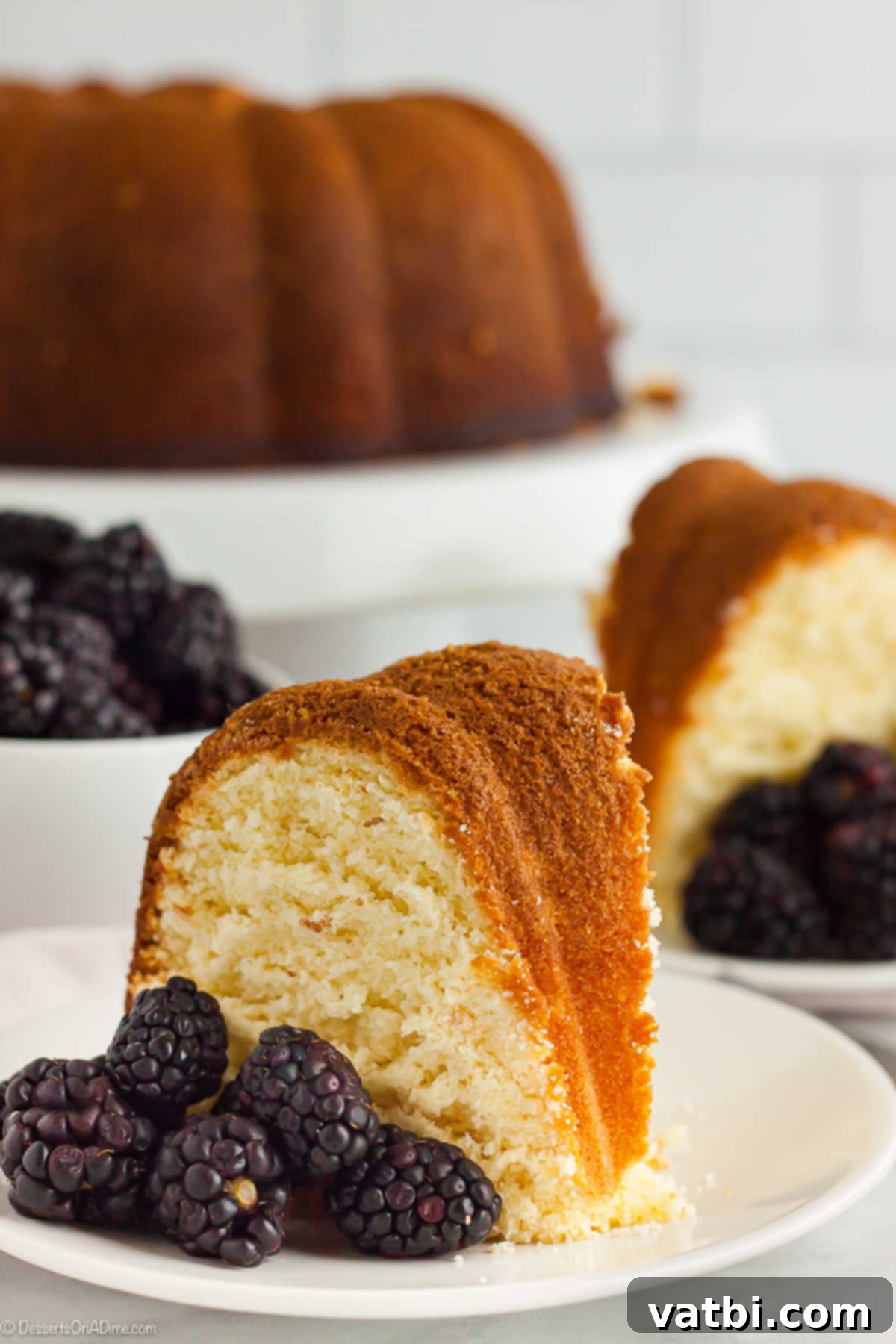
This Easy Classic Pound Cake Recipe stands out for its simplicity and the incredible results it delivers. We love that this cake is wonderfully soft, beautifully spongy, and has that signature dense texture that pairs so perfectly with the tart sweetness of fresh berries. While it sometimes gets overlooked in favor of more elaborate desserts, I truly believe this classic pound cake is one of the most satisfying and versatile cakes to serve. Its understated elegance and profound flavor make it a true showstopper.
If you’re a chocolate lover looking for a rich twist, don’t miss our Chocolate Pound Cake. For those who enjoy other delightful baking adventures, we also recommend exploring our Angel Food Cake Recipe, known for its airy lightness, and our comforting Apple Bundt Cake, perfect for autumn flavors.
Table of contents
- Why is a Pound Cake called a Pound Cake?
- Pound Cake Vs Bundt Cake
- Key Ingredients for the Perfect Pound Cake
- Delicious Variations and Additions
- How to Make a Pound Cake from Scratch
- Expert Tips for the Best Pound Cake
- Frosting Ideas to Elevate Your Pound Cake
- Irresistible Toppings
- Storage and Freezing Tips
- Frequently Asked Questions (FAQs)
- More Easy Cake Recipes You’ll Love
Why is a Pound Cake Called a Pound Cake? Understanding the Classic Name
The name “Pound Cake” has a fascinating origin story deeply rooted in traditional baking. A traditional pound cake earned its name from the sheer quantities of its original ingredients. The earliest recipes for this beloved dessert were remarkably simple, often featuring only four core components: a pound of flour, a pound of sugar, a pound of butter, and a pound of eggs. This precise, equal-weight ratio of ingredients made it easy for home bakers to remember and prepare, and thus, the iconic name “Pound Cake” was born.
Over time, as baking techniques evolved and culinary preferences diversified, many bakers began to adapt and refine this classic recipe. Modern pound cakes often include additional ingredients like leavening agents (though traditionally they didn’t rely on them), milk, or flavorings to achieve an even lighter texture or unique taste profile. However, the fundamental essence of a dense, rich, and moist cake remains, honoring its historical roots. Exploring different Pound Cake Recipes reveals just how versatile this simple concept can be.
Pound Cake Vs. Bundt Cake: Clarifying the Difference
It’s common to confuse pound cake with bundt cake, primarily because pound cakes are very often baked in bundt pans. However, there’s a distinct difference between the two, which lies in their fundamental nature:
- Pound Cake – Refers to the type of cake itself. It is characterized by its thick, dense, and heavy crumb, often rich in butter and eggs. It’s known for its robust structure and deeply satisfying texture, a direct result of its traditional ingredient ratios.
- Bundt Cake – This term refers to the pan in which a cake is baked, not the cake batter itself. A Bundt pan is a distinctive ring-shaped mold, often with fluted or intricate designs. You can bake almost any type of cake batter – from chocolate to vanilla, or even an angel food cake – in a Bundt pan. While many pound cakes are beautifully presented when baked in a Bundt pan, the pan doesn’t define the cake’s recipe or texture. It simply gives it a recognizable shape.
So, while your delicious, easy pound cake might come out of a beautiful Bundt pan, it’s the recipe that makes it a pound cake, not the pan!
Key Ingredients for the Perfect Pound Cake
This easy pound cake recipe relies on a few high-quality ingredients to achieve its signature taste and texture. Using the right ingredients and preparing them properly is crucial for a moist and flavorful outcome. The complete list of ingredients with exact measurements is available in the recipe card below, but let’s highlight some key components:
- Unsalted Butter. This is arguably the most important ingredient. Ensure your butter is truly softened to room temperature before you begin. This allows it to cream properly with the sugar, incorporating air and creating a tender, even crumb. Using unsalted butter gives you control over the salt content in the recipe.
- Granulated Sugar. Beyond sweetness, sugar plays a vital role in pound cake’s texture. It helps to keep the cake moist by attracting and holding onto moisture. Creaming it thoroughly with butter creates air pockets, contributing to the cake’s volume and fine crumb.
- Eggs & Egg Yolks. A generous amount of eggs contributes to the rich flavor, structure, and moistness of the pound cake. The extra egg yolks specifically add richness and help create that classic dense, tender texture without making the cake too crumbly.
- Vanilla Extract. Pure vanilla extract is essential for a classic pound cake flavor. Don’t skimp on quality here, as it makes a noticeable difference. It enhances all the other flavors in the cake.
- Salt. A touch of salt balances the sweetness and brings out the depth of flavor in the butter and vanilla.
- All-Purpose Flour. While some recipes call for cake flour, good quality all-purpose flour works wonderfully in this recipe, yielding a sturdy yet tender cake. Proper measurement is key to avoid a dry or tough cake.
Scroll to the very bottom and get the entire ingredients list with precise measurements in our printable recipe card.
Delicious Variations and Additions
While this classic easy pound cake recipe is perfect as is, it also serves as a fantastic base for creativity. Feel free to experiment with these simple variations and additions to customize your pound cake to your liking:
- Use a flavored extract. Beyond vanilla, different extracts can completely transform the flavor profile of your pound cake. Consider using:
- Lemon extract: For a bright, zesty cake.
- Almond extract: To add a sophisticated, nutty aroma.
- Mint extract: For a refreshing, unexpected twist, especially delightful with chocolate chips.
- Coconut extract: To give your cake a tropical flair.
Start with a small amount and adjust to taste, as some extracts are more potent than vanilla.
- Add in citrus juice and zest. For an incredibly vibrant flavor, especially for a Lemon Pound Cake or orange pound cake, incorporating fresh citrus is a game-changer.
- Lemon zest and lemon juice: The zest contains aromatic oils that provide intense flavor, while the juice adds a bright, tangy note and helps keep the cake moist.
- Orange zest and orange juice: For a sweeter, sunnier profile, a wonderful alternative.
Add the zest to the butter and sugar mixture for maximum flavor infusion, and the juice with the wet ingredients.
- Stir in chocolate chips, nuts, or fruit. Towards the end of mixing the batter, gently fold in your favorite mix-ins. This adds texture and bursts of flavor.
- Chocolate chips: Mini or standard, dark, milk, or white chocolate chips all work beautifully.
- Fresh berries: Blueberries, raspberries, or chopped strawberries can add a lovely juiciness and tartness. Lightly toss them in a tablespoon of flour before adding to prevent them from sinking to the bottom.
- Mashed bananas: For a subtly sweet and extra moist banana pound cake.
- Chopped nuts: Pecans, walnuts, or almonds add a delightful crunch and nutty flavor.
- Marble Swirl: For a visual and flavor delight, divide the batter in half, mix cocoa powder into one half, and then alternate spoonfuls of each batter into the pan, swirling gently with a knife for a beautiful marbled effect.
How to Make a Pound Cake from Scratch: A Step-by-Step Guide
Baking a homemade pound cake from scratch is a rewarding experience, and with these clear instructions, you’ll achieve a perfect result every time. Follow along with these steps to create your own moist and delicious classic pound cake.
- Step 1. First, preheat your oven to 350°F (175°C). This ensures the oven is at the correct temperature when the cake goes in, allowing for even baking. Next, generously grease and flour a 10-inch Bundt pan or tube pan. This crucial step prevents the cake from sticking. Make sure to get into all the crevices of a Bundt pan. Shake out any excess flour and set the prepared pan aside. You can also use a high-quality non-stick cooking spray specifically designed for baking.
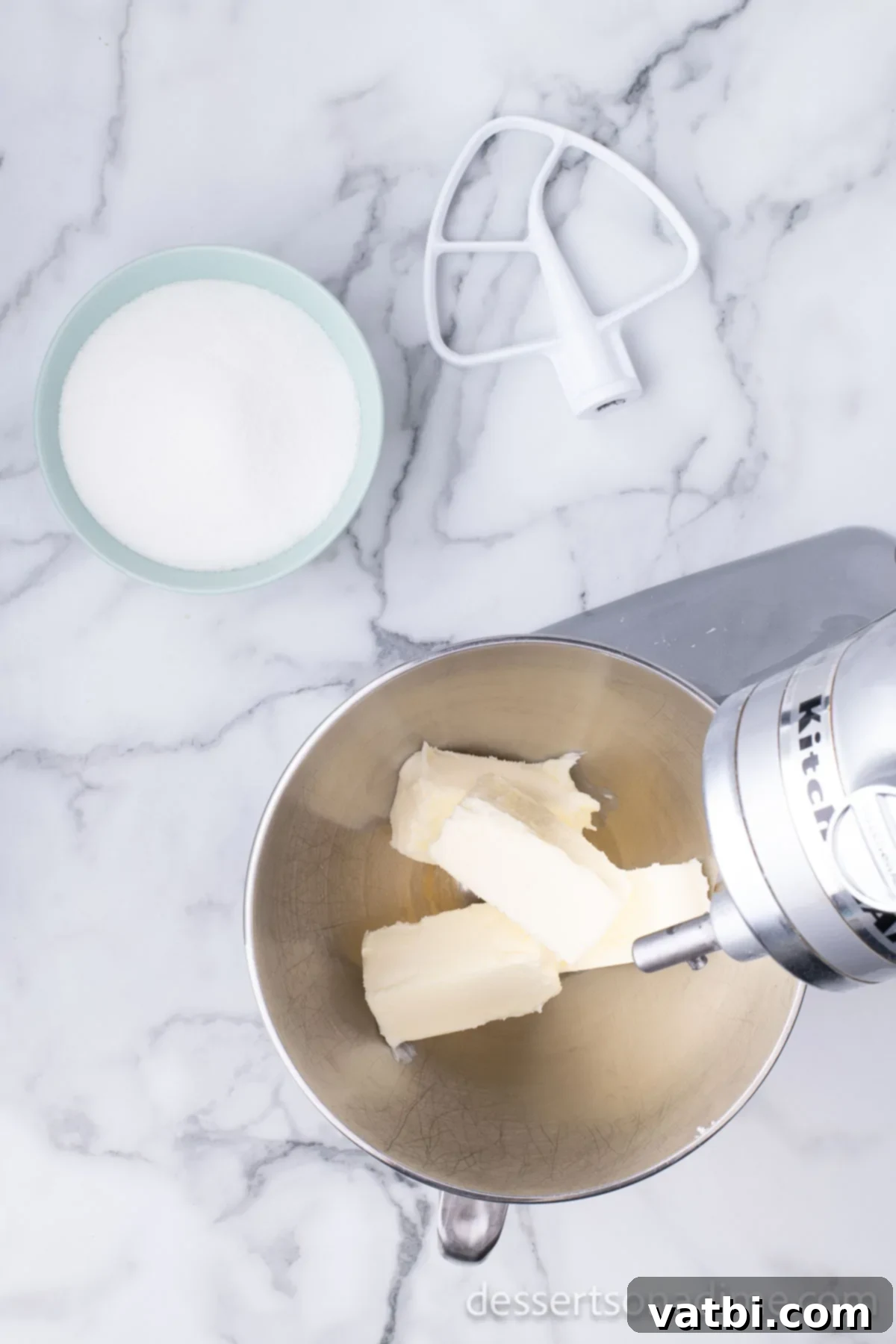
Step 2. Next, place your softened unsalted butter into the bowl of a stand mixer fitted with the paddle attachment. If you don’t have a stand mixer, a hand mixer will also work effectively for this recipe. Ensure the butter is truly at room temperature for the best creaming results.
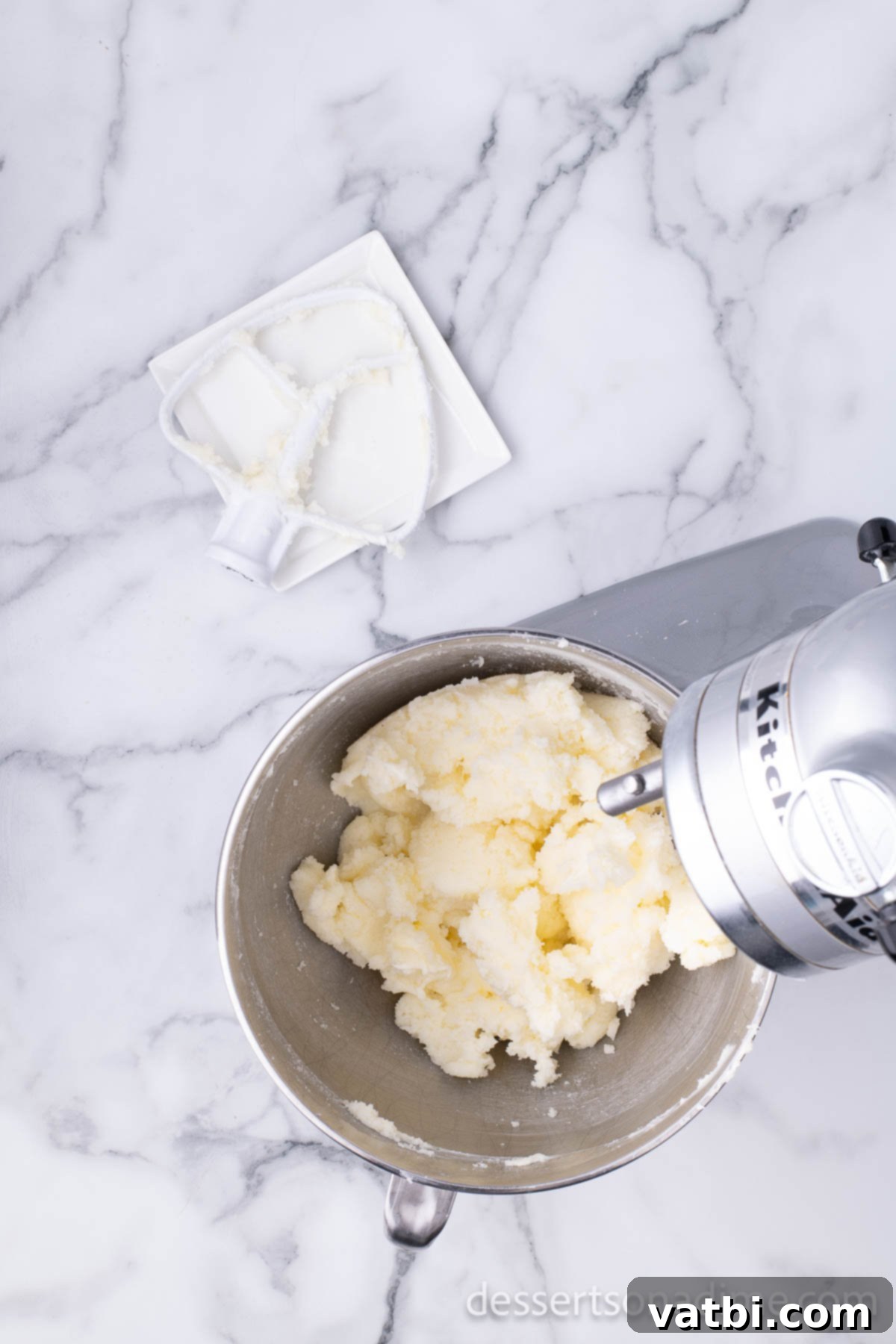
Step 3. In the mixer, beat the butter on medium-high speed until it becomes wonderfully creamy and smooth. This typically takes a couple of minutes. Then, pause the mixer, scrape down the sides of the bowl with a spatula to ensure everything is evenly mixed, and add the granulated sugar. Continue to mix the butter and sugar together until they are well combined, light in color, and fluffy. This creaming process incorporates air, which is crucial for the pound cake’s texture.
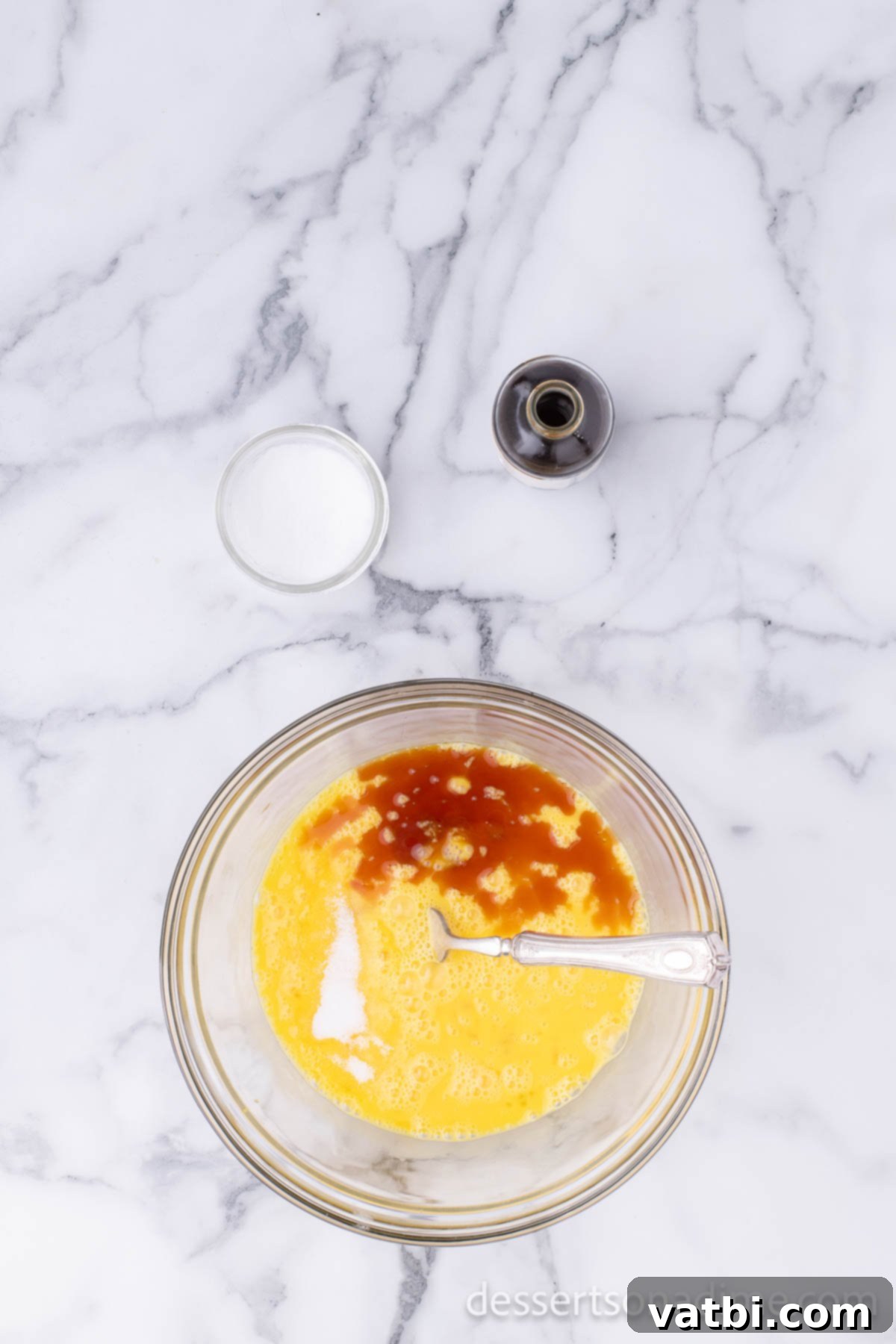
Step 4. In a separate, medium-sized bowl, combine the large whole eggs, additional large egg yolks, pure vanilla extract, and salt. Gently whisk these ingredients together with a fork until the egg yolks are broken and the mixture is well combined. Ensure all ingredients are at room temperature.
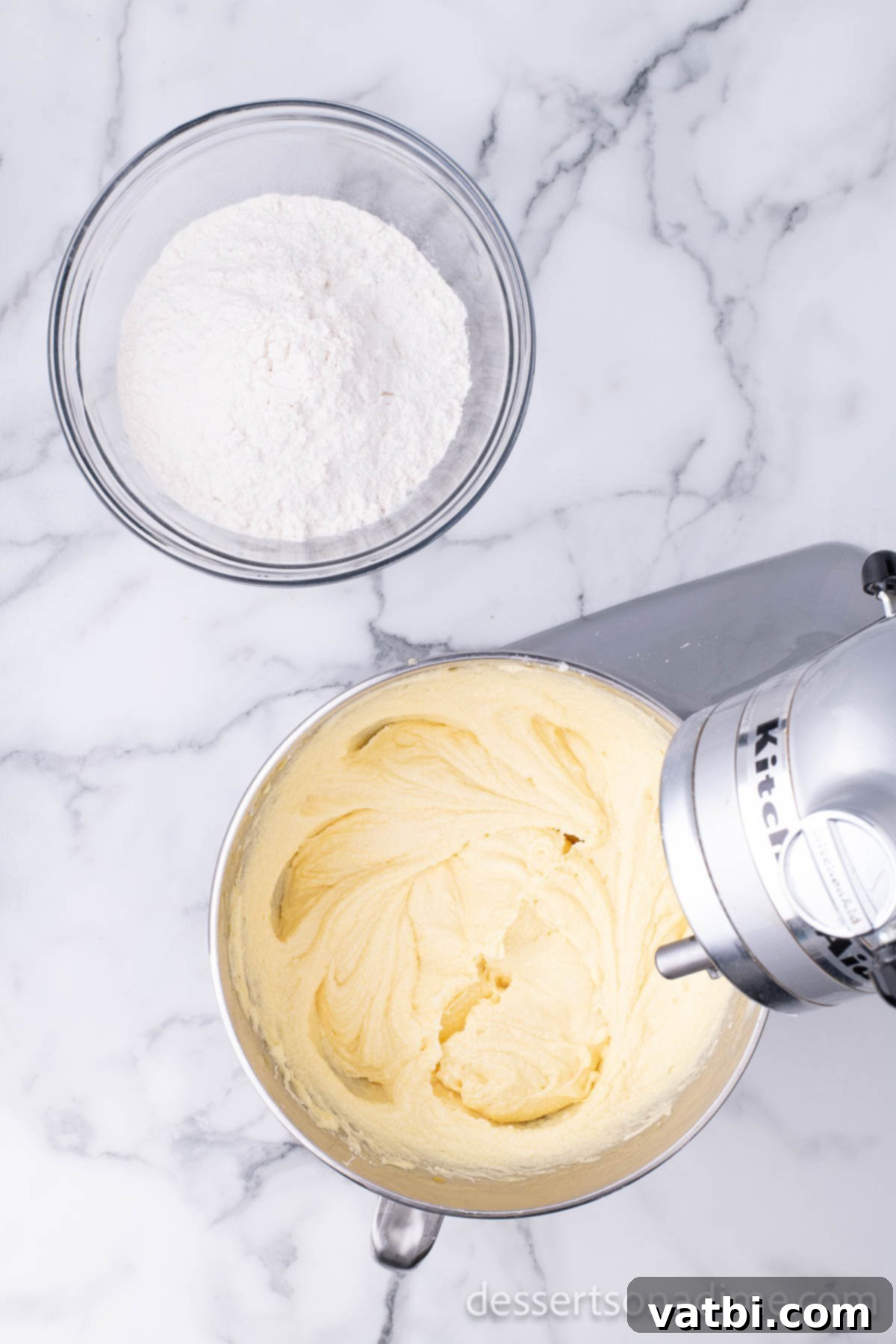
Step 5. With your mixer running on low speed, slowly pour the egg mixture into the butter and sugar batter. Allow it to mix together gradually, incorporating a little at a time. This slow addition helps create a smooth, emulsified batter. Once the egg mixture is fully incorporated, reduce the speed to low again and gradually add the all-purpose flour, about half a cup at a time, until it’s just combined. Avoid overmixing at this stage.
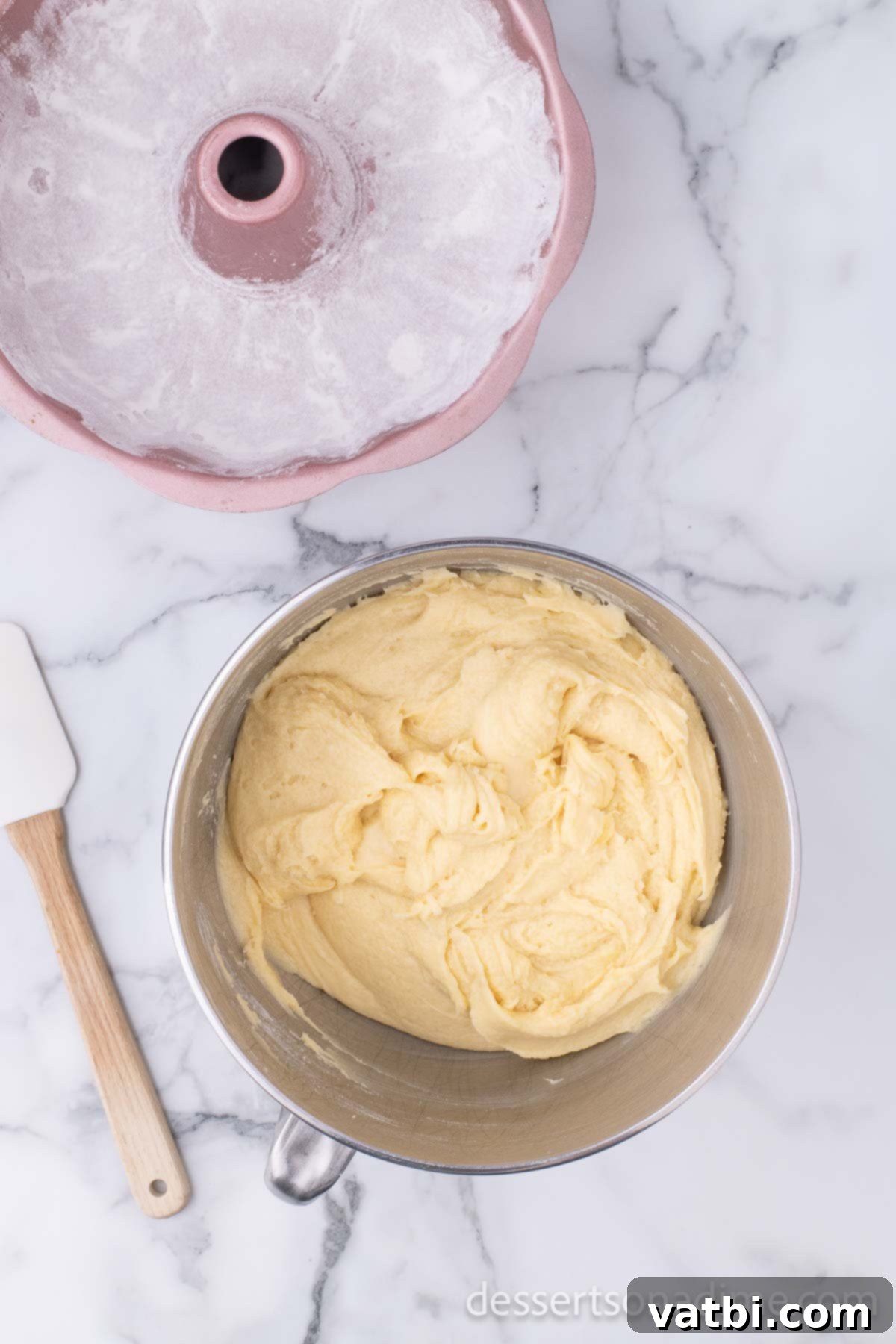
Step 6. Once all the flour has been added, stop the mixer. Scrape down the sides and bottom of the bowl again thoroughly with your spatula to ensure no dry pockets of flour remain. Then, beat on medium speed for just another minute until the batter is smooth and well-combined. Be careful not to overmix, as this can lead to a tough cake.
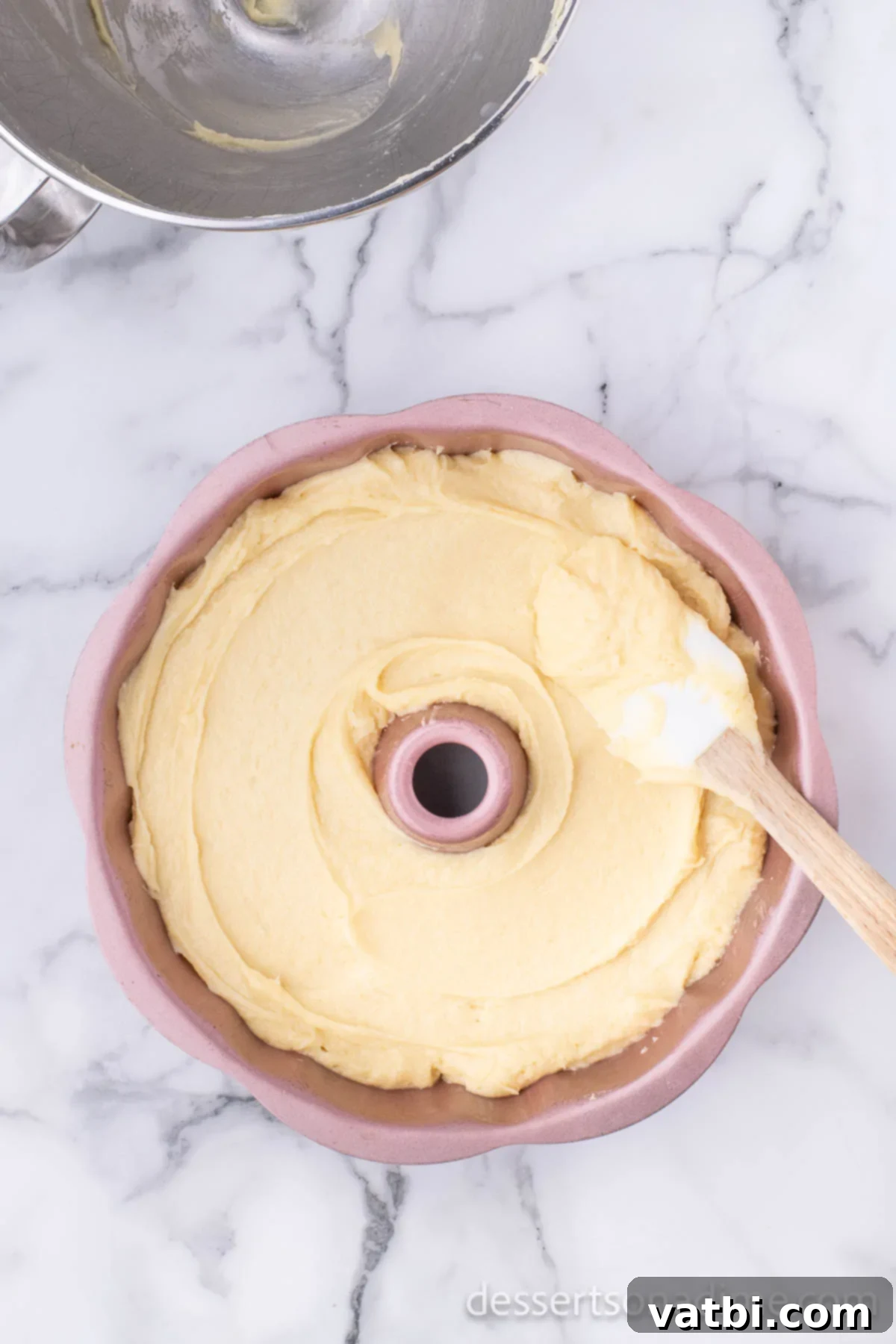
Step 7. Your luscious pound cake batter is now perfectly prepared and ready to be baked. Carefully spread the batter evenly into your generously greased and floured Bundt pan. Use a spatula to smooth the surface of the batter, ensuring it’s evenly distributed in the pan. This helps the cake bake evenly and achieve a beautiful, consistent rise.
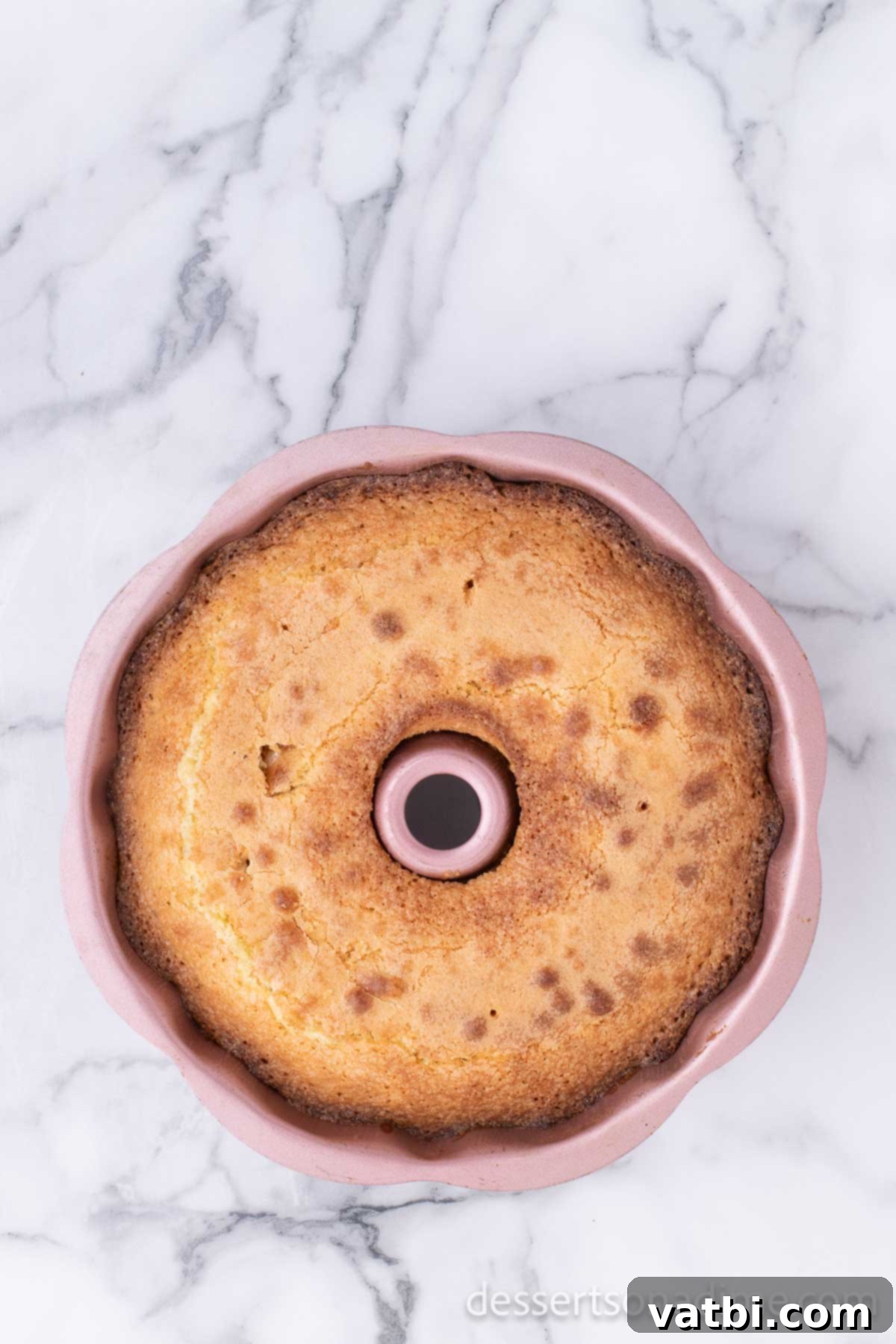
Step 8. Bake the pound cake in your preheated oven at 350°F for approximately 60-75 minutes. Baking times can vary slightly depending on your oven, so it’s important to test for doneness. Insert a wooden toothpick or a thin skewer into the center of the thickest part of the cake; if it comes out clean with no wet batter, the cake is ready. Be careful not to overbake, as this can lead to a dry cake.
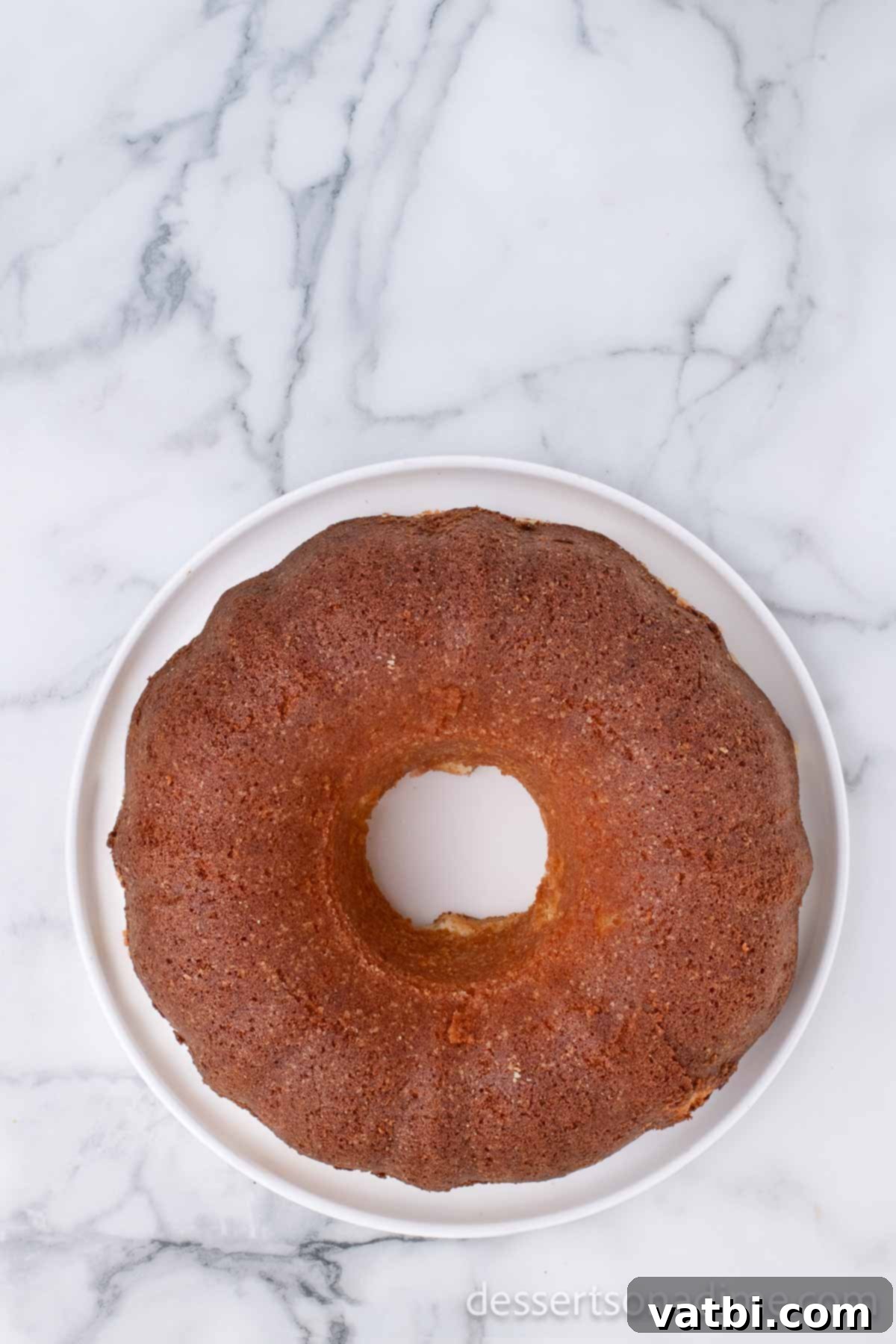
Step 9. Once baked, allow the cake to cool in the pan on a wire rack for at least 15-20 minutes. This cooling time in the pan helps the cake set and makes it easier to remove without breaking. After the initial cooling, run a thin knife gently around the sides of the Bundt pan and the center tube to loosen the cake from the pan. Next, carefully invert the pound cake onto a cooling rack and allow it to cool completely before slicing and serving. This slow, complete cooling is essential for the cake’s texture and for any glazes or frostings you might add.
Expert Tips for the Best Pound Cake Every Time
Achieving a truly perfect, moist, and tender pound cake is simple when you follow a few key tips from experienced bakers. These insights will help you avoid common pitfalls and ensure your homemade pound cake is a resounding success.
- It’s best to use room temperature ingredients when making this classic easy pound cake recipe. This is not just a suggestion; it’s a crucial step. Room temperature butter, eggs, and even milk (if your recipe includes it) combine much more effectively than cold ingredients. They emulsify better, creating a smooth, uniform batter that traps air efficiently, resulting in a lighter, more tender crumb.
- Let the butter soften at room temperature naturally. Patience is key here. Do not try to speed up the process by using the microwave. Melted butter has a different molecular structure than softened butter, and it will not cream properly with the sugar. Using melted butter can lead to a flat, greasy, and dense cake rather than the desired light and airy texture of a perfect pound cake.
- Make sure not to over mix when adding in the egg mixture or the flour mixture. Overmixing develops the gluten in the flour too much, which can cause your cake to become dry, tough, and even crack when baking. Mix just until the ingredients are combined and no streaks of flour remain. Use accurate measuring cup and spoons to ensure correct ratios.
- I recommend using real butter (not margarine) for this recipe. Butter provides unmatched flavor and richness that margarine simply cannot replicate. The fat content and composition of real butter contribute significantly to the pound cake’s texture and overall deliciousness.
- Don’t open the oven door too early. Resist the temptation to check on your pound cake too frequently, especially in the first 45 minutes of baking. A sudden drop in temperature can cause the cake to fall in the middle, resulting in a dense, sunken center.
- Cool the cake properly. Allow the cake to cool in the pan for the recommended time before inverting it. This allows the cake’s structure to set, making it less prone to breaking when removed from the pan. Fully cooling on a wire rack afterward is also important for the final texture.
Frosting Ideas to Elevate Your Pound Cake
While this classic easy pound cake is absolutely delicious on its own, a touch of frosting can transform it into an even more decadent treat. Here are a few of our favorite frosting recipes that we love topping this versatile cake with, each offering a unique flavor and texture profile:
- Cream Cheese Frosting: The tangy sweetness of a classic cream cheese frosting provides a wonderful contrast to the rich, buttery flavor of the pound cake. Its smooth, creamy texture is incredibly satisfying.
- Peanut Butter Frosting: For those who love a nutty, savory-sweet combination, a fluffy peanut butter frosting is a surprisingly delicious pairing with pound cake. It adds a delightful depth of flavor.
- Marshmallow Frosting: Light, airy, and wonderfully sweet, marshmallow frosting adds a whimsical touch and a delicate sweetness that complements the pound cake without overpowering it.
- Homemade Buttercream Icing: A simple, rich buttercream is a timeless choice. Its smooth consistency and buttery flavor enhance the pound cake, making it feel even more celebratory.
You can also keep it simple with a light dusting of powdered sugar, a simple lemon glaze, or a drizzle of chocolate ganache for an elegant finish.
Irresistible Toppings for Your Pound Cake
Beyond frostings, simple toppings can beautifully enhance the natural flavors of this classic easy pound cake, making each slice a special experience. Here are some of our top recommendations:
- Whipped Cream and Berries – This is a quintessential pairing for pound cake, and for good reason! The light, airy texture and delicate sweetness of Homemade Whipped Cream Recipe perfectly complement the dense crumb of the cake. When combined with a medley of fresh, seasonal berries – think strawberries, blueberries, raspberries, or blackberries – you get a burst of fresh, tart flavor and vibrant color that makes every bite truly delicious and refreshing.
- Ice Cream – Especially during warmer months, serving a warm slice of pound cake with a scoop of your favorite ice cream is an absolute treat. The contrast between the warm cake and cold, melting ice cream is heavenly. Our No Churn Strawberry Ice Cream, with its fruity sweetness, is a particularly fantastic choice that I love to serve over this easy pound cake recipe. Vanilla bean ice cream or a rich chocolate ice cream would also be superb.
- Fruit Compote or Sauce – Homemade fruit compotes (like cherry, peach, or mixed berry) or a simple fruit sauce can add a gourmet touch. The cooked fruit enhances the natural sweetness of the cake with a slightly tart counterpoint.
- Chocolate Syrup or Caramel Drizzle – For an extra indulgent treat, a drizzle of high-quality chocolate syrup or a luscious homemade caramel sauce can elevate your pound cake to new heights, adding another layer of sweetness and richness.
Storage and Freezing Tips for Your Pound Cake
Proper storage is essential to keep your delicious homemade pound cake fresh and moist for as long as possible. Whether you plan to enjoy it over a few days or save it for a later treat, these tips will help maintain its quality.
- Room Temperature Storage: Store any leftover pound cake in an airtight container at room temperature for up to 5 days. Keeping it well-sealed prevents it from drying out. If you’re storing slices, it’s a good idea to separate them with parchment paper to prevent them from sticking together. A cake dome or a tightly sealed plastic container works perfectly.
- Refrigeration: While pound cake can be refrigerated, it tends to dry out slightly faster in the fridge. If your kitchen is very warm or humid, or if your cake has a perishable frosting, refrigeration might be necessary. In this case, wrap it tightly in plastic wrap before placing it in an airtight container. Bring it to room temperature before serving for the best flavor and texture.
- Freezing for Longer Storage: Pound cake freezes beautifully, making it an excellent option for meal prep or saving for unexpected guests. To freeze, ensure the cake is completely cooled. Wrap the entire cake or individual slices tightly with plastic wrap, then an additional layer of aluminum foil. This double layer helps prevent freezer burn. Place the wrapped cake in a freezer bag or an airtight freezer-safe container. It can be frozen for up to 3-6 months.
- Defrosting: To defrost frozen pound cake, simply remove it from the freezer and let it sit out at room temperature, still wrapped, for several hours or overnight. This slow thawing process helps retain moisture. Once thawed, unwrap and enjoy! For more detailed instructions and tips on freezing, see our guide on Can You Freeze Pound Cake.

Frequently Asked Questions (FAQs) About Pound Cake
Here are answers to some of the most common questions about baking and enjoying pound cake, ensuring you have all the information you need for a perfect bake.
For this particular easy pound cake recipe, I consistently achieve excellent results using a 10-inch Bundt pan. This size is often referred to as a 12-cup Bundt pan. The classic fluted design not only ensures even baking but also creates a beautiful presentation that needs little more than a dusting of powdered sugar. A good quality, heavy-gauge aluminum Bundt pan will conduct heat evenly and provide a nice, golden crust.
Absolutely, this versatile pound cake batter can be successfully baked in loaf pans! If you prefer slices or want to make smaller cakes for gifting, simply pour the prepared cake batter into two standard loaf pans (9×5 inches), ensuring they are also generously greased and floured. Bake at 350°F (175°C) for approximately 50-60 minutes, or until a toothpick inserted into the middle of each loaf comes out clean. Keep an eye on them, as baking times can vary between loaf pans and Bundt pans.
Several factors contribute to a moist pound cake. Firstly, the generous amount of sugar and egg combination in this recipe is crucial; sugar is a hygroscopic ingredient, meaning it attracts and retains moisture. Therefore, do not reduce the sugar amount unless specified by a tested recipe. Secondly, pound cake is meant to be a dense cake but should never be dry. Overcooking the cake is the quickest way to make it dry, so watch it closely when baking and remove it promptly once a toothpick comes out clean. Lastly, overmixing the batter can lead to gluten development, resulting in a tough, dry cake. Mix ingredients only until just combined.
The true secret to an exceptional pound cake lies in two fundamental principles: using room temperature ingredients and avoiding overmixing your cake batter. Room temperature ingredients blend harmoniously, creating a smooth emulsion that traps air for a tender crumb. Overmixing, on the other hand, develops gluten excessively, making the cake tough and dry. By adhering to these key points – patient preparation and gentle mixing – you will consistently achieve a pound cake with that coveted light, airy yet dense texture and rich flavor.
Pound cake overflowing from the pan is often a result of overmixing the ingredients. Overbeating incorporates too much air into the batter, which expands excessively during baking, causing the cake to rise too much and then spill over the edges. It can also happen if the pan is too small for the amount of batter. Always ensure you’re using the correct size pan and mix only until combined, not more.
The most reliable method to check if your pound cake is finished cooking is to use a wooden toothpick or a thin skewer. Insert it into the very center of the thickest part of the cake. If it comes out clean, without any wet batter or moist crumbs clinging to it, then the cake is done. If there is still wet batter, continue baking for a few more minutes and test again. Avoid overbaking, as this is a common cause of dry cake.
The beauty of a classic easy pound cake is its versatility with toppings. This recipe is fantastic with almost any type of frosting you prefer. A simple dusting of powdered sugar, a light lemon glaze, or a rich chocolate ganache are all excellent choices. For a creamier option, traditional buttercream, cream cheese frosting, or even a delightful peanut butter frosting (as suggested above) pair wonderfully. You can easily make your own homemade frosting or opt for a good quality store-bought one for convenience.
A pound cake falling in the middle is typically caused by one of two things: either it’s underbaked, or the batter was overbeaten. If the cake is underbaked, its structure hasn’t fully set, and it will collapse as it cools. If the batter was overbeaten, too much air was incorporated, creating large bubbles that weaken the cake’s internal texture, causing it to sink. Ensure you follow the baking time guidelines and test for doneness carefully, and mix ingredients only until just combined.
While some pound cake recipes might call for self-rising flour, it’s generally not recommended for this classic version. Self-rising flour contains leavening agents (baking powder and salt), and this particular pound cake recipe is designed to rise primarily from the air incorporated into the butter and sugar, and the leavening power of the eggs. Using self-rising flour could result in an overly airy or crumbly texture that isn’t true to the dense, rich nature of a traditional pound cake. Stick to all-purpose flour for the best results with this recipe.
More Easy Cake Recipes You’ll Love
If you enjoyed making this classic easy pound cake and are looking for more delightful baking projects, we have a collection of other simple yet delicious cake recipes that are sure to impress your family and friends. From comforting classics to exciting new flavors, there’s something for every sweet craving:
- Old Fashioned Hummingbird Cake
- Cream Cheese Puffs Recipe
- Hawaiian Wedding Cake
- Orange Pound Cake
- Lemon Pound Cake Recipe
- Easy S’Mores Cake Recipe
We hope this comprehensive guide inspires you to bake and enjoy this wonderful classic easy pound cake. It’s truly a recipe that stands the test of time, perfect for creating cherished memories around the table. It’s your turn to try this wonderful recipe. Don’t forget to come back and leave a comment sharing your experience and any delicious variations you tried!
Pin
Easy Pound Cake Recipe
Ingredients
- 2 cups unsalted butter softened
- 3 ½ cups granulated sugar
- 6 large whole eggs
- 6 large egg yolks
- 1 Tablespoon vanilla extract
- 1 teaspoon salt
- 3 1/2 cups all-purpose flour
Instructions
-
Preheat your oven to 350F and generously grease and flour a 10″ bundt pan. Shake out excess flour and set aside.
-
Place your butter in a standing mixer. Beat the butter until it is creamy and smooth.
-
Scrape down the sides of the bowl and add the sugar. Beat until the ingredients are well combined and light and fluffy (about 2 minutes).
-
In a separate, medium-sized bowl, combine your eggs, egg yolks, vanilla extract, and salt.
-
Use a fork to lightly beat the eggs until egg yolks are broken up and salt and vanilla are incorporated.
-
With mixer on low speed, slowly pour egg mixture into your batter, allowing it to mix together slowly.
-
Once all of the egg mixture is incorporated, scrape down the sides and bottom of the bowl, then increase speed to medium-high and beat for another 1-2 minutes.
-
Reduce mixer speed back to low and gradually, about ½ cup at a time, add flour to the batter until all has been added to the mixer.
-
Scrape down the sides and bottom of bowl and mix again on medium speed until well-combined for another minute.
-
Spread batter evenly into the prepared bundt pan. Use a spatula to smooth the surface of the batter on the top of the pan.
-
Bake for 60-75 minutes or until a toothpick inserted in the center of the thickest part of the cake comes out clean. Do not over bake.
-
Allow the cake to cool for at least 20 minutes then run a knife around the sides of the bundt pan and the center.
-
Carefully invert the pound cake onto a cooling rack and allow to cool completely before serving.
-
Slice and serve!
Nutrition Facts
Pin This Now to Remember It Later
Pin Recipe
